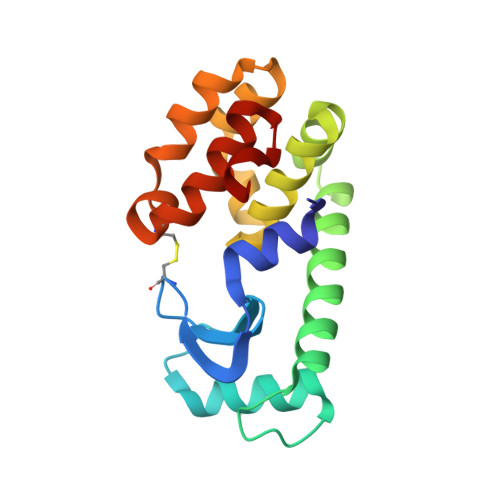Structure of a stabilizing disulfide bridge mutant that closes the active-site cleft of T4 lysozyme.
Jacobson, R.H., Matsumura, M., Faber, H.R., Matthews, B.W.(1992) Protein Sci 1: 46-57
- PubMed: 1304882
- DOI: https://doi.org/10.1002/pro.5560010106
- Primary Citation of Related Structures:
1KNI - PubMed Abstract:
The engineered disulfide bridge between residues 21 and 142 of phage T4 lysozyme spans the active-site cleft and can be used as a switch to control the activity of the enzyme (Matsumura, M. & Matthews, B.W., 1989, Science 243, 792-794). In the oxidized form the disulfide increases the melting temperature of the protein by 11 degrees C at pH 2. The crystal structure of this mutant lysozyme has been determined in both the reduced and oxidized forms. In the reduced form, the crystal structure of the mutant is shown to be extremely similar to that of wild type. In the oxidized form, however, the formation of the disulfide bridge causes the alpha-carbons of Cys 21 and Cys 142, on opposite sides of the active-site cleft, to move toward each other by 2.5 A. In association with this movement, the amino-terminal domain of the protein undergoes a rigid-body rotation of 5.1 degrees relative to the carboxy-terminal domain. This rotation occurs about an axis passing through the junction of the amino-terminal and carboxy-terminal domains and is also close to the axis that best fits the apparent thermal motion of the amino-terminal domain seen previously in crystals of wild-type lysozyme. Even though the engineered Cys 21-Cys 142 disulfide links together the amino-terminal and carboxy-terminal domains of T4 lysozyme, it does not reduce the apparent mobility of the one domain relative to the other. The pronounced "hinge-bending" mobility of the amino-terminal domain that is suggested by the crystallographic thermal parameters of wild-type lysozyme persists in the oxidized (and reduced) mutant structures. In the immediate vicinity of the introduced disulfide bridge the mutant structure is more mobile (or disordered) than wild type, so much so that the exact conformation of Cys 21 remains obscure. As with the previously described disulfide bridge between residues 9 and 164 of T4 lysozyme (Pjura, P.E., Matsumura, M., Wozniak, J.A., & Matthews, B.W., 1990, Biochemistry 29, 2592-2598), the engineered cross-link substantially enhances the stability of the protein without making the folded structure more rigid.
Organizational Affiliation:
Department of Physics, University of Oregon, Eugene 97403.
















